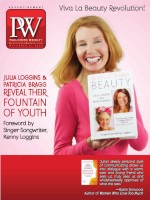Journalist Danielle Friedman first delved into “The Secret Sexual History of the Barre Workout” in a 2018 article for New York magazine’s The Cut. She expands on that piece and tracks the evolution of the women’s fitness industry in Let’s Get Physical (Putnam, Jan. 2022), which PW called a “zippy history.” Here, Friedman discusses writing the book she most wanted to read.
What got you interested in women’s fitness history?
In the months before my wedding, I became motivated to try my first barre class. I loved the way barre classes made me feel, but as a feminist and women’s health journalist, I was intrigued by barre subculture and its origins. I was struck by how sexual some of the moves felt and wondered if anyone had ever looked into the impact of barre on sexual health. There was a much larger cultural history of women’s fitness that had never been told. At one point I thought, “It would be great to talk to whoever wrote the book on women’s fitness,” and I was surprised to find that book didn’t exist.
How did women’s fitness culture go from verboten—“women don’t sweat”—to mainstream?
When the book begins in the 1950s, there was this prevailing cultural belief that women shouldn’t sweat, have visible muscles—even that vigorous exercise could be dangerous for a woman, would cause her uterus to fall out. Women were up against cultural and medical barriers to exercise. Beliefs started to change around the rise of the women’s movement. Second-wave feminists encouraged women to become strong, to participate in sports. By the end of the ’70s, looking sporty, for better or worse, was sexy. I try to convey the tensions that have existed from the beginning in women’s fitness: exercise as a tool for women to become strong, or a tool of the patriarchy to control how women feel about their bodies.
What most surprised you during your research?
One theme I found so interesting was the late ’70s explosion of women’s fitness launched a new class of women innovators and inventors—women pioneering the workouts but also pioneering the gear. Necessity was the mother of invention in the women’s fitness space, particularly the sports bra. I was struck by the fact it wasn’t invented until 1977. The prototype was sewing together two jockstraps. It changed the landscape of women’s movement.
How can readers turn exercise from a chore into a joy?
It sounds simple, but start by asking yourself what kind of movement makes you feel good. Forget about what you should be doing and do what you enjoy. The best workout is the one that you’ll do. In our culture, there’s an idea that to be involved in fitness you have to take on a new lifestyle. We’re burnt out enough and that can feel really overwhelming, and we end up doing nothing because it’s like, “I don’t have time for that.” You don’t need fancy gear, an expensive membership, or hours a day to benefit from movement; you just have to move in any way that feels good. There’s something to be said for using movement and exercise as a way to appreciate what our bodies can do and not always expect more from them.



 Volume 268
Issue 44
11/01/2021
Volume 268
Issue 44
11/01/2021





